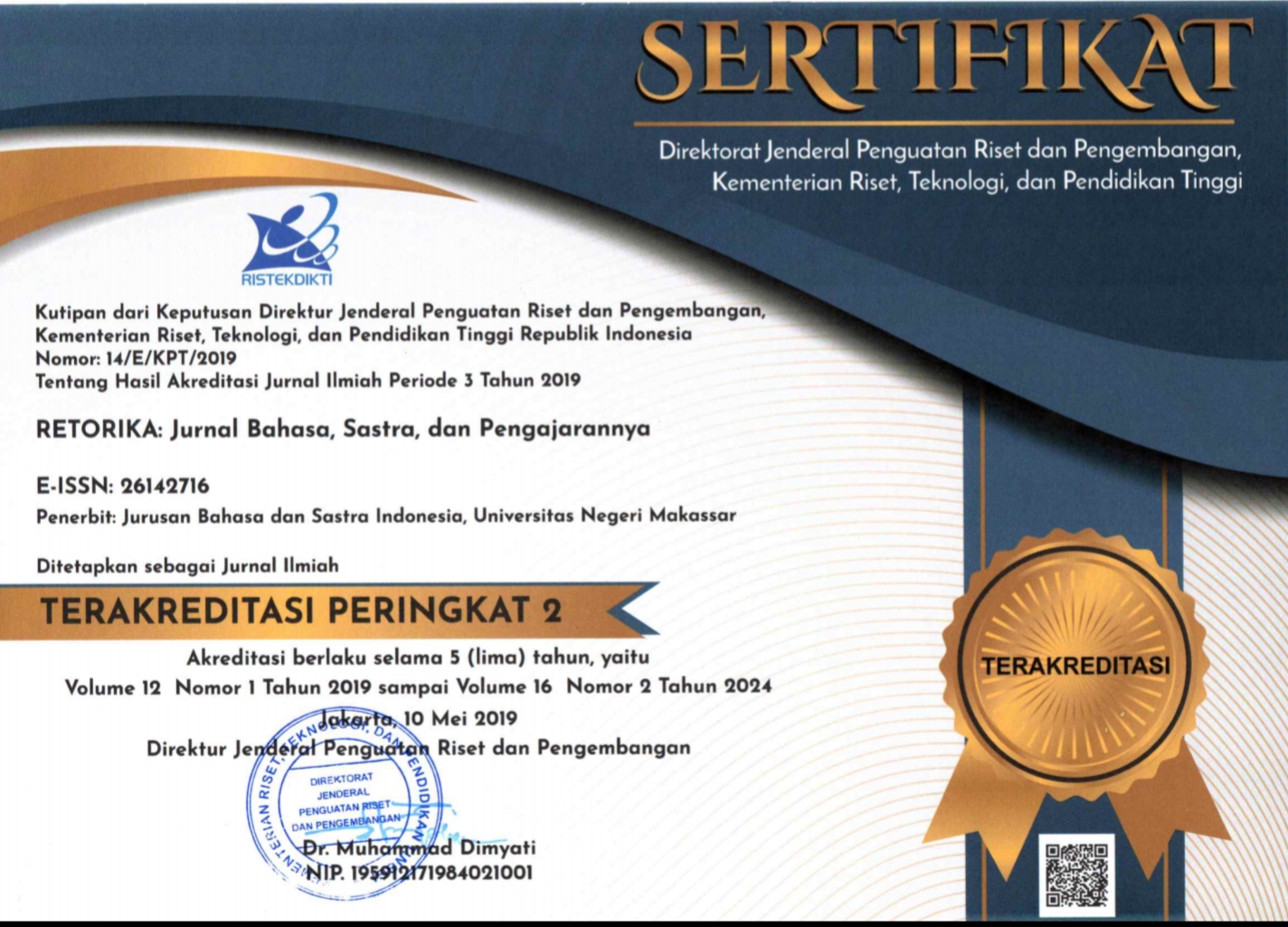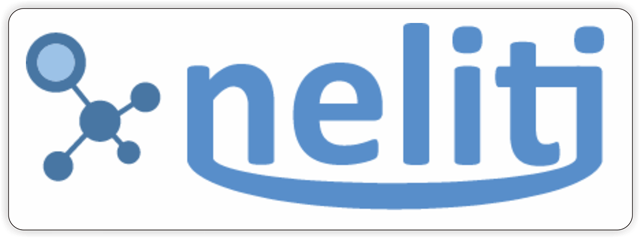IMPLEMENTATION OF GOOGLE CLASSROOM APPS TO IMPROVE CREATIVE WRITING SKILLS
(1) Universitas Muhammadiyah Makassar
(2) Universitas Muhammadiyah Makassar
(3) Universitas Muhammadiyah Makassar
(*) Corresponding Author
DOI: https://doi.org/10.26858/retorika.v16i1.43389
Abstract
Keywords
Full Text:
PDFReferences
Al-Maroof, R. A. S., & Al-Emran, M. (2018). Students acceptance of Google classroom: An exploratory study using PLS-SEM approach. International Journal of Emerging Technologies in Learning (iJET), 13(06), 112-123.
Arifin, Suci Ramadhani, Etha Gustin Merdekawati. (2020) Responses Students on Utilization of Google Classroom as Online Learning Media. JUSTIN (Journal of Systems and Information Technology, 08(3), 278-281.
Badley, G. F. (2019). Post-academic Writing: Human Writing for Human Readers. Qualitative Inquiry, 25(2), 180-191.
Bennui, P. (2016). A study of L1 Intereference in The Writing of Thai EFL students. Malaysian Journal of ELT Research, 4(1), 31.
Claro, M., Salinas, Á., Cabello-Hutt, T., San Martín, E., Preiss, D. D., Valenzuela, S.,& Jara, I. (2018). Teaching in a Digital Environment (TIDE): Defining and Measuring Teachers' Capacity to Develop Students' Digital Information and Communication Skills. Computers & Education, 121, 162-174.
Cloutier, C. (2016). How I write: An Inquiry Into The Writing Practices of Academics. Journal of Management Inquiry, 25(1), 69-84.
Dafit, F. (2017). Ability Effectiveness Elementary Students' Creative Writing with the Multiliteracy Learning Model. GERAM, 5(1), 49-57.
Day, C., Gu, Q., & Sammons, P. (2016). The Impact of Leadership on Student Outcomes: How Successful School Leaders Use Transformational and Instructional Strategies To Make A Difference. Educational administration quarterly, 52(2), 221-258.
Dewanti, P. (2019). Optimalisasi Digital Native di Era Industri 4.0. Teknomatika, 9(1).
Fareed, M., Ashraf, A., & Bilal, M. (2016). ESL Learners‟ Writing Skills: Problems, Factors and Suggestions. Journal of Education and Social Sciences, 4(2), 81- 92.
Fitrihana, N. (2018). Teaching Factory Learning Design at Fashion Design Vocational School. Home Economics Journal, 2(2), 56-64.
Febriyani. G.D. (2017). Writing Learning Creative Poetry Using Diorama Media for Class VII Students of MTs Nurul Falah Cimahi Academic Year 2016/2017. (Doctoral) Dissertation, FKIP UNPAS).
Ghavifekr, S., & Rosdy, W. A. W. (2015). Teaching and Learning With Technology: Effectiveness of ICT Integration In Schools. International Journal of Research in Education and Science, 1(2), 175-191.
Hammi, Z. (2017). Google implementation Classroom in Class XI IPA MAN 2 Kudus. (Doctoral Dissertation), State University of Semarang.
Jones, D., & Christensen, C. A. (1999). Relationship Between Automaticity in Handwriting and Students' Ability to Generate Written Text. Journal of Educational Psychology, 91(1), 44.
Kafyulilo, A., Fisser, P., Pieters, J., & Voogt, J. (2015). ICT Use In Science and Mathematics Teacher Education In Tanzania: Developing Technological Pedagogical Content Knowledge. Australasian Journal Of Education Technology, 31(4).
Laurillard, D. (2016). The Educational Problem That Moocs Can Solve: Professionals Development for Teachers Of Disadvantaged Students. Research in Learning Technology, 24.
Lazuardi, D. R., & Murti, S. (2018). Enhancement Ability to Write Poetry Using the VAK Quantum Learning Model (Visual, Audiovisual, Kinesthetic). KiBASP Journal (Language, Literature and Teaching Studies), 2(1), 87-95.
Lee, S. H., Sergueeva, K., Catangui, M., & Kandaurova, M. (2017). Assessing Google Cardboard Virtual Reality As A Content Delivery System in Business Classrooms. Journal of Education for Business, 92(4), 153-160.
Lengelle, R., Meijers, F., & Hughes, D. (2016). Creative Writing For Life Design: Reflexivity, Metaphor and Change Processes Through Narrative. Journal of Vocational Behavior, 97, 60-67.
Marlatt, R. (2019). I Didn T Say,„Macbeth,‟It Was My Google Doc!”: A Secondary English Case Study of Redefining Learning In The 21st Century. E-learning and Digital Media, 16(1), 46-62.
Molderez, I., & Fonseca, E. (2018). The Efficacy Of Real-World Experiences And Service Learning for Fostering Competences for Sustainable Development in Higher Education. Journal of Cleaner Production, 172, 4397-4410.
Pourhosein Gilakjani, A., & Sabouri, N. B. (2016). How Can Students Improve Their Reading Comprehension Skill. Journal of Studies in Education, 6(2), 229-240.
Ruiz-Funes, M. (2015). Exploring the Potential of Second/Foreign Language Writing for Language Learning: The Effects Of Task Factors And Learner Variables. Journal of Second Language Writing, 28, 1-19.
Sahin, N., & Polatcan, F. (2019). The Effect of Creative Writing Exercises in Turkish Classes on Students' Academic Achievement: A Meta-Analysis. International Online Journal of Educational Sciences, 11(2).
Sulistijani, E., Fransori, A., & Youlinda, F. (2018). Literary Creative Writing Activities for Grade VII Middle School Students in East Jakarta as a Form of the School Literacy Movement. Nusa: Journal of Language and Literature, 13(3), 370-379.
Supraja, M. (2018). Introduction To Critical Social Science Methodology Jurgen Habermas. UGM PRESS.
Sugiyono, (2013) Educational Research Methods: (Quantitative, Qualitative and R &D). Alphabet.
Smith, H. (2020). The Writing Experiment: Strategies for Innovative Creative Writing. Routledge.
Syahruddin, S., Ahdan, A., & Ernawati, E. (2019). Application of Online Mode Professional Development in Enhancing Pedagogical and Professional Competencies in Early Grade Primary School Teacher. JPP (Jurnal Pendidikan dan Pembelajaran), 26(1), 36-42.
Syakur, A. (2020). The Effectiveness of English Learning Media through Google Classroom in Higher Education. Britain International of Linguistics Arts and Education (BIoLAE) Journal, 2(1), 475 - 483.
Tondeur, J., Forkosh-Baruch, A., Prestridge, S., Albion, P., & Edirisinghe, S. (2016). Responding to Challenges in Teacher Professional Development For ICT Integration in Education. Journal of Educational Technology & Society, 19(3), 110-120.
Volk, M., Cotič, M., Zajc, M., & Starcic, A. I. (2017). Tablet-Based Cross-Curricular Maths Vs. Traditional Maths Classroom Practice for Higher-Order Learning Outcomes. Computers & Education, 114, 1-23.
Widowati, W., Sawitri, S., & Krisnawati, M. (2015). Learning Model Effectiveness Project Based Under Improvement Student Learning Outcomes in the Eyes Design Development Course. TEKNOBUGA: Journal of Fashion and Food Technology, 2(2).
Windarti, A., & Ardiansyah, A. N. (2018). The Effect Of Using The Google Classroom Application On Quality Learning And Student Learning Outcomes In Class XI Economics Subject At MAN 1 South Tangerang City. Bachelor's Thesis, Jakarta: Faculty of Tarbiyah and Teacher Training Sciences UIN Syarif Hidayatullah).
Wu, Y. C. J., Wu, T., & Li, Y. (2019). Impact of Using Classroom Response Systems on Students' Entrepreneurship Learning Experience. Computers in Human Behavior, 92, 634-645.
Article Metrics
Abstract view : 184 times | PDF view : 69 timesRefbacks
- There are currently no refbacks.
Copyright (c) 2023 Syahruddin Syahruddin, M. Agus, Amal Akbar, Sakaria Sakaria

This work is licensed under a Creative Commons Attribution-NonCommercial 4.0 International License.
Published by:
Department of Indonesian Language, Faculty of Languages and Literature, Universitas Negeri Makassar in cooperate with Asosiasi Dosen Bahasa dan Sastra Indonesia (ADOBSI) and Ikatan Program Studi Pendidikan Bahasa dan Sastra Indonesia (IKAPROBSI).
Address: Department of Indonesian Language Office, DG Building Second Floor, UNM Parangtambung, Daeng Tata Raya Street, Makassar, South Sulawesi, Indonesia
 Email: retorika@unm.ac.id
Email: retorika@unm.ac.id

RETORIKA: Jurnal Bahasa, Sastra,dan Pengajarannya is licensed under a Creative Commons Attribution-NonCommercial 4.0 International License.
















